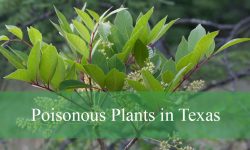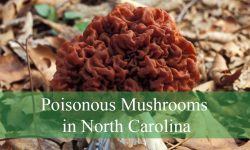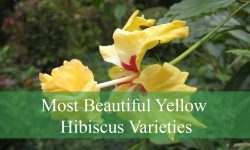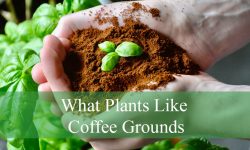If you garden in the Sunshine State, you know palm trees are more than just beautiful—they’re a symbol of Florida’s tropical charm and relaxed lifestyle. Understanding the different types of palm trees in Florida helps you choose the best palms for your yard or garden, making your outdoor space truly special.
Florida’s climate supports a wide variety of palm species, each with unique looks, growth habits, and care needs. From the iconic Sabal Palm, our state tree, to rare and exotic palms seen in botanical gardens, the types of palm trees in Florida offer options for almost every garden spot. Knowing these palms ensures you pick those that will thrive in your environment.
This guide covers 42 popular types of palm trees in Florida, complete with pictures and key identification tips. Whether you are an experienced gardener or just getting started, this list will help you recognize and care for the palms that give Florida its lush, tropical feel.
Different Types of Palm Trees That Thrive in Florida
Sabal Palm (Sabal palmetto)

The Sabal Palm, also known as the cabbage palm, is the official state tree of Florida and one of the most iconic native palms in the southeastern United States. It features a sturdy, unbranched trunk topped with a dense crown of fan-shaped fronds that can reach up to 15 feet in length. Mature trees can grow up to 60-70 feet tall, although they typically grow slowly, often taking decades to reach full height.
This palm is well-adapted to a variety of soils and can thrive in salt-prone, coastal environments as well as inland areas. It is commonly found throughout Florida, especially in natural hammocks, pinelands, and along highways. The trunk often shows the characteristic “bootjacks” — the remains of old leaf bases that have not fallen away completely.
Sabal Palms are highly drought-tolerant once established and require minimal care. They grow best in USDA hardiness zones 8B through 11, making them suitable for most parts of Florida. For optimal growth, plant in full sun to partial shade with well-drained soil. They do not require pruning unless removing dead fronds and are resistant to most pests and diseases.
Royal Palm (Roystonea regia)
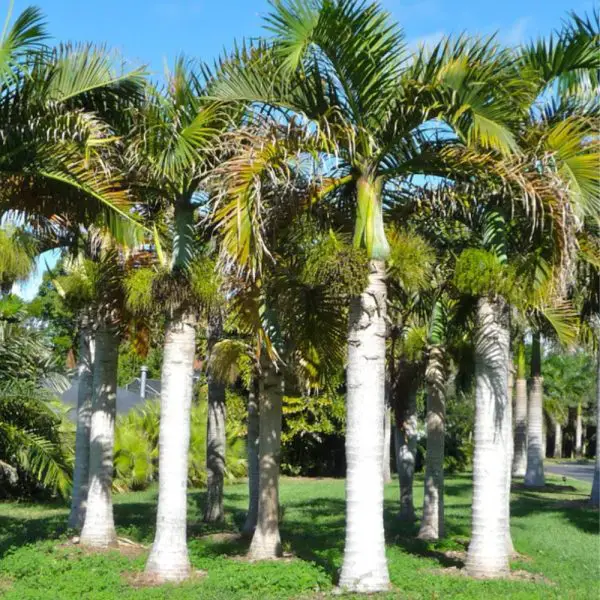
The Royal Palm is one of the most majestic and instantly recognizable palm trees, often used in grand landscaping designs. It is known for its tall, smooth, gray trunk and striking green crown shaft, which supports a symmetrical canopy of long, feathery fronds. This palm can grow rapidly under the right conditions and may reach heights of 80 to 100 feet.
Native to Florida, the Caribbean, and parts of Central America, the Royal Palm is commonly seen lining streets, public parks, and luxury properties in South Florida. Its upright, columnar shape and regal appearance make it a favorite in tropical and subtropical landscaping. Young trees are sometimes more sensitive to cold, but mature specimens handle occasional chills quite well.
Royal Palms thrive in USDA zones 10 to 11 and prefer full sun exposure. They need rich, moist, well-drained soil and benefit from regular watering, especially during dry spells. Fertilize with a balanced palm fertilizer to prevent nutrient deficiencies. While not overly high-maintenance, they do appreciate some care to maintain their elegant form and healthy foliage.
Areca Palm (Dypsis lutescens)

The Areca Palm, often called the butterfly palm or golden cane palm, is a popular ornamental palm used both outdoors in landscaping and indoors as a decorative houseplant. It features multiple thin, clumping trunks with arching, feathery fronds that have a bright green color and a soft texture. Areca Palms typically grow 6 to 12 feet tall indoors and up to 20 feet or more outdoors.
This species is native to Madagascar but is widely cultivated in South and Central Florida due to its fast growth and tropical appearance. It’s a common sight in gardens, near patios, or as privacy screens in residential settings. The yellowish stalks and clustered growth make it easy to distinguish from other palms.
Areca Palms do best in USDA zones 10 to 11. They prefer partial shade to full sun and need consistently moist but well-drained soil. When grown indoors, they require bright, indirect light and regular watering to prevent leaf tip browning. They benefit from regular feeding with a palm-specific fertilizer and should be pruned occasionally to remove dead fronds.
Bismarck Palm (Bismarckia nobilis)

The Bismarck Palm is an eye-catching palm species prized for its massive size and unique, silver-blue fronds. It has a stout, solitary trunk and a full, symmetrical crown of fan-shaped leaves that can span up to 10 feet across. This palm can grow up to 40-70 feet tall and adds a bold, architectural statement to landscapes.
Native to Madagascar, the Bismarck Palm thrives in South and Central Florida, especially in well-drained, sunny areas. Its coloration and robust form make it easy to identify, and it’s often used as a focal point in large yards or commercial properties. Due to its size, it’s not suitable for small gardens or tight spaces.
This palm grows best in USDA hardiness zones 9B to 11. It prefers full sun and is tolerant of drought once established. Young palms should be watered regularly until a strong root system is developed. Avoid planting too close to structures or other trees. It requires minimal maintenance, though it’s important to provide adequate space and protection from strong winds when young.
Fishtail Palm (Caryota mitis)
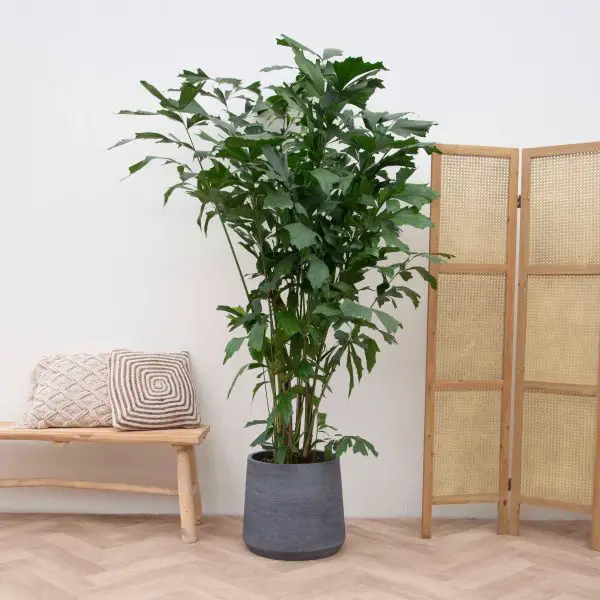
The Fishtail Palm is named for its unusual, jagged-edged fronds that resemble the tail of a fish, making it one of the most distinctive palms for tropical landscaping. It grows as a clustering palm, producing multiple stems that can reach heights of 10 to 25 feet. The fronds are bipinnate, giving them a full, lush appearance.
Originally from Southeast Asia, this palm does well in the warm and humid conditions of South Florida. It’s commonly found in tropical gardens, shaded patios, and indoor atriums. Its layered look and interesting leaf shape set it apart from more traditional feather or fan palms.
Fishtail Palms are suitable for USDA zones 10 to 11 and prefer partial shade to full sun. They need consistently moist, well-drained soil and benefit from regular watering and high humidity. Fertilize with a palm-specific blend to encourage healthy growth. Prune away dead stems as needed, but be cautious — the sap can be irritating to the skin for some people.
Majesty Palm (Ravenea rivularis)
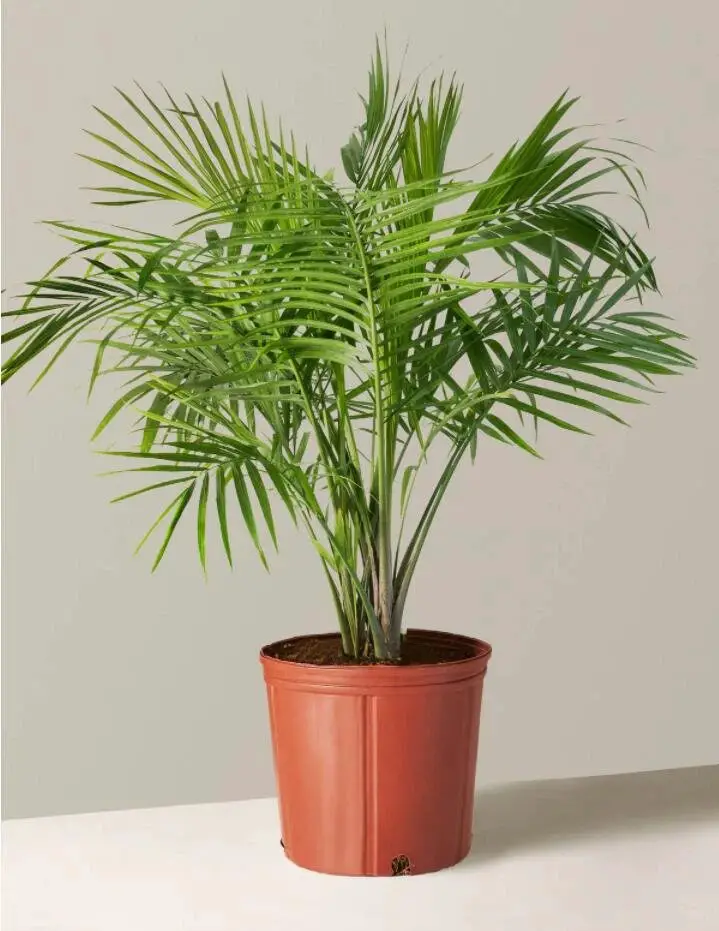
The Majesty Palm is a graceful, tropical palm known for its soft, feathery fronds and elegant upright appearance. It features a single smooth trunk and arching green leaves that can span several feet, giving it a lush, fountain-like form. While it can grow up to 40 feet outdoors in ideal tropical climates, it is more commonly kept as a houseplant, where it stays much smaller.
Native to Madagascar, the Majesty Palm has become a popular indoor plant across Florida and the United States due to its attractive foliage and relatively easy care. In South Florida, it is occasionally grown outdoors in shady, moist areas. Indoors, it’s typically placed in bright rooms with indirect sunlight.
This palm prefers USDA hardiness zones 10 to 11. It thrives in moist, well-drained soil and needs regular watering to prevent the soil from drying out, especially in containers. Humidity is important for indoor specimens, as dry air can lead to browning leaf tips. Fertilize every 2–3 months during the growing season with a balanced palm fertilizer, and avoid direct harsh sunlight indoors.
Paurotis Palm (Acoelorrhaphe wrightii)
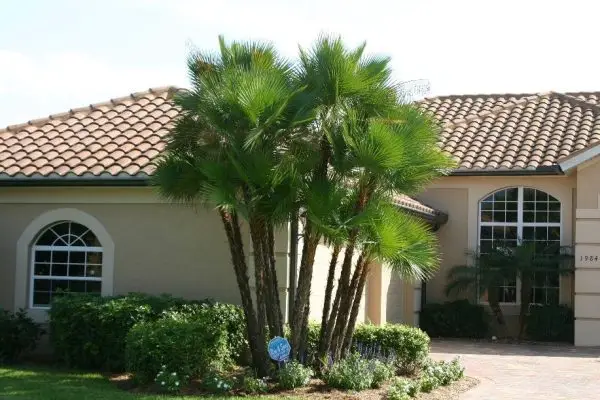
The Paurotis Palm, also known as Everglades Palm, is a native Florida species that forms dense, multi-stemmed clumps of slender trunks. It has fan-shaped green fronds with silver undersides and can grow up to 25 feet tall. Its clustered form and upright growth make it popular for screening or tropical-themed landscaping.
This palm naturally occurs in the southern Everglades and throughout South Florida wetlands. It’s commonly used in landscape designs for coastal areas and public parks because of its resilience to flooding and salt spray. The attractive color contrast between the green tops and silvery bottoms of its fronds adds visual interest.
Paurotis Palms thrive in USDA zones 9B to 11 and prefer full sun to partial shade. They require moist, fertile soil and perform best with regular watering, although they can tolerate some drought once established. Trimming the lower fronds occasionally helps maintain a neat appearance. Due to its suckering habit, it needs room to spread if planted in clusters.
Needle Palm (Rhapidophyllum hystrix)
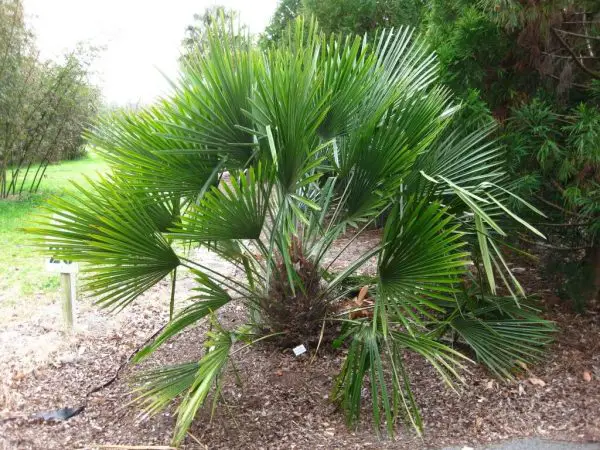
The Needle Palm is one of the most cold-hardy palms in the world, making it an excellent choice for North Florida gardens. It has a clumping, shrub-like habit with fan-shaped dark green leaves and sharp needle-like spines at the base of the leaf stems. It grows slowly and typically reaches 6 feet in height and width.
Native to the southeastern United States, including parts of northern Florida, the Needle Palm is found in moist, wooded habitats like floodplains and shaded hammocks. Its compact size and resilience to cold weather make it a top pick for under-canopy planting or as a foundation palm in colder zones.
It thrives in USDA hardiness zones 6B to 11 and prefers partial shade, although it can tolerate full sun with sufficient moisture. It likes well-drained, slightly acidic soil and benefits from occasional watering during dry periods. It’s a low-maintenance palm that resists pests and diseases and can handle freezing temperatures with minimal protection.
Florida Thatch Palm (Thrinax radiata)
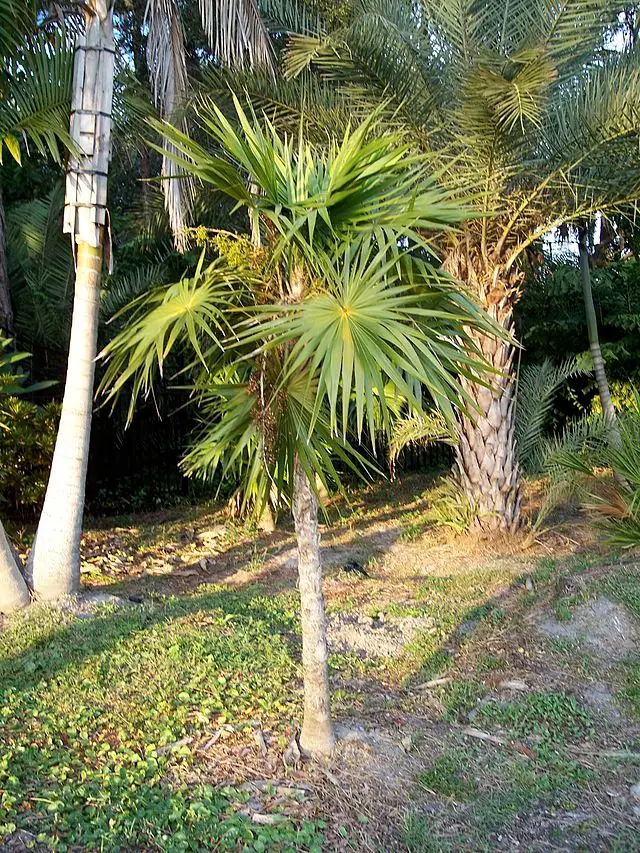
The Florida Thatch Palm is a slender, single-trunk palm native to the southern tip of Florida and the Florida Keys. It has a smooth gray trunk and a rounded crown of fan-shaped green fronds with stiff, pointed segments. Typically, it grows slowly and reaches heights of 20 to 25 feet at maturity.
This native palm is often found in coastal uplands, sandy soils, and limestone outcrops. Its salt tolerance and elegant form make it ideal for seaside landscapes and small tropical gardens. It’s recognized for its clean, narrow silhouette and minimal maintenance needs, making it a favorite for upscale residential designs.
Florida Thatch Palms are best suited to USDA zones 10B to 11. They prefer full sun but tolerate light shade and require well-drained soil. Once established, they are drought-tolerant and need only occasional watering. Pruning is minimal, usually just to remove old or damaged fronds. They are also resistant to most palm pests and diseases.
Key Thatch Palm (Coccothrinax argentata)
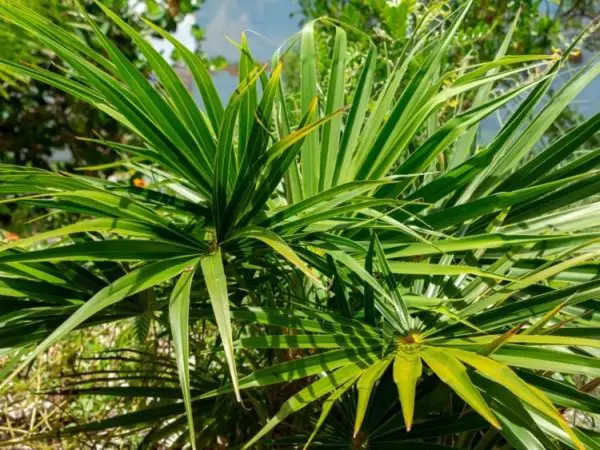
The Key Thatch Palm is a beautiful native species known for its shimmering, silver-backed fronds and slim trunk. Its crown is made up of stiff, circular fan-shaped leaves with striking contrast between the glossy green tops and the silvery undersides. It grows slowly and typically reaches 15 to 20 feet in height.
This palm is native to the Florida Keys and parts of South Florida, where it grows in rocky soils and coastal environments. Its drought and salt tolerance make it especially well-suited for xeriscaping and beachside plantings. Its ornamental appearance and resilience make it a great choice for sustainable landscapes.
Best grown in USDA zones 10A to 11, the Key Thatch Palm thrives in full sun and well-drained, sandy soils. It needs very little water once established and requires minimal care. Occasional fertilization during the growing season can enhance leaf color. It is best planted where its silver fronds can be appreciated from below or backlit by sunlight.
Cat Palm (Chamaedorea cataractarum)
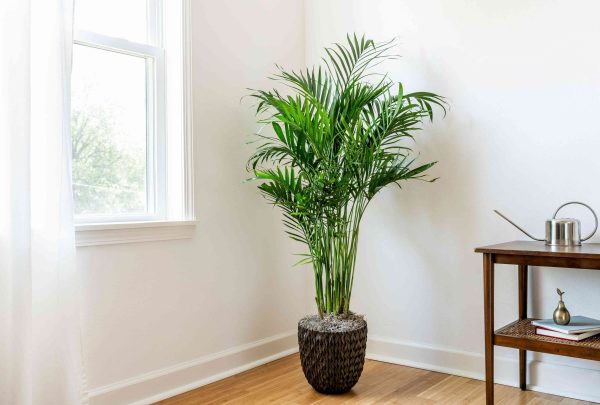
The Cat Palm is a compact, clumping palm with rich green, arching fronds that resemble a soft tropical fountain. Unlike many palms, it lacks a central trunk and grows in a dense, bushy form. Its fine-textured foliage and non-invasive roots make it ideal for use around patios, walkways, and indoors in containers.
This palm is native to Mexico and Central America, and in Florida, it’s commonly used in shaded gardens or as an understory plant. It thrives in humid environments and performs best in sheltered locations where it is protected from strong wind and full sun. It’s also a favorite for interior landscaping in malls and homes due to its manageable size and aesthetic appeal.
Cat Palms grow best in USDA hardiness zones 9B to 11. They prefer filtered light or partial shade and need consistently moist, well-draining soil rich in organic matter. Regular watering and high humidity are key to healthy growth, particularly indoors. Fertilize lightly with a balanced palm formula during the growing season, and avoid letting the soil dry out completely.
Bamboo Palm (Chamaedorea seifrizii)
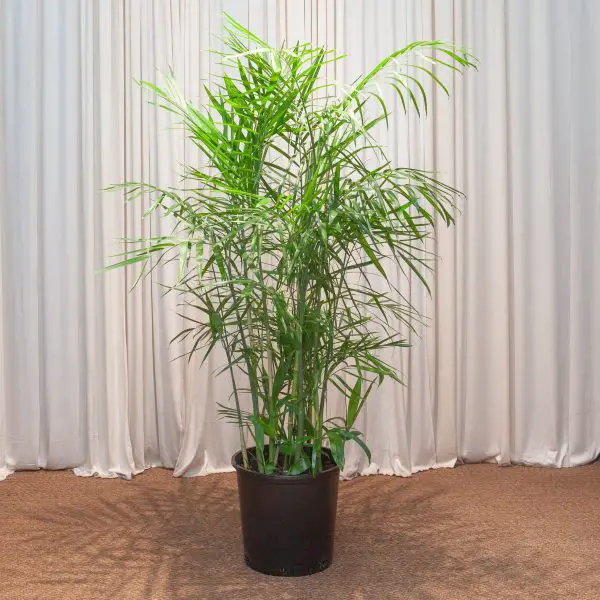
The Bamboo Palm is a graceful, clustering palm that resembles bamboo due to its tall, cane-like stems and feathered fronds. Each stem is ringed and slender, topped with pinnate green leaves that give a light, airy texture. It typically reaches 8 to 12 feet outdoors but remains smaller in containers.
Originally native to Mexico and Central America, the Bamboo Palm is popular in Florida as both an indoor plant and a shaded landscape feature. It’s often used in homes and offices because of its vertical habit and ability to purify the air. Outdoors, it’s well-suited to tropical garden designs, especially in protected, shady spots.
Bamboo Palms thrive in USDA zones 10A to 11. They do best in partial to full shade with moist, well-drained soil. Avoid direct sun, which can scorch the leaves. Regular watering and humidity are essential, especially indoors. Trim dead or yellowing fronds to keep the plant tidy, and fertilize every few months with a diluted palm fertilizer.
Parlor Palm (Chamaedorea elegans)
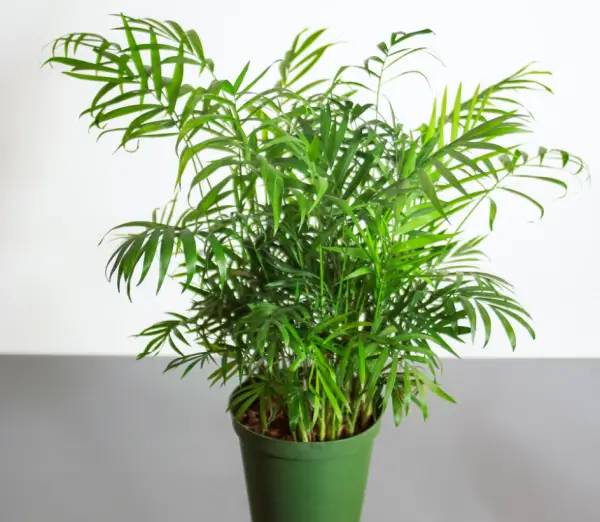
The Parlor Palm is a classic houseplant palm known for its elegant, upright stems and soft, feather-like fronds. It stays small, usually under 6 feet tall, and grows slowly, making it perfect for indoor environments where space is limited. Its delicate, dark green foliage creates a sophisticated, Victorian charm.
Native to the rainforests of southern Mexico and Guatemala, the Parlor Palm is widely cultivated throughout Florida as an interior decorative plant. It’s one of the few palms that can tolerate low light and dry indoor air, making it extremely versatile for homes, apartments, and offices.
It grows best in USDA zones 10 to 11 and requires bright, indirect light indoors or dappled shade outdoors. The soil should be kept evenly moist but not soggy, and good drainage is essential to prevent root rot. Avoid overwatering and feed with a diluted liquid fertilizer every few months. This palm is extremely low-maintenance and resilient to most pests.
Beccariophoenix Palm (Beccariophoenix alfredii)
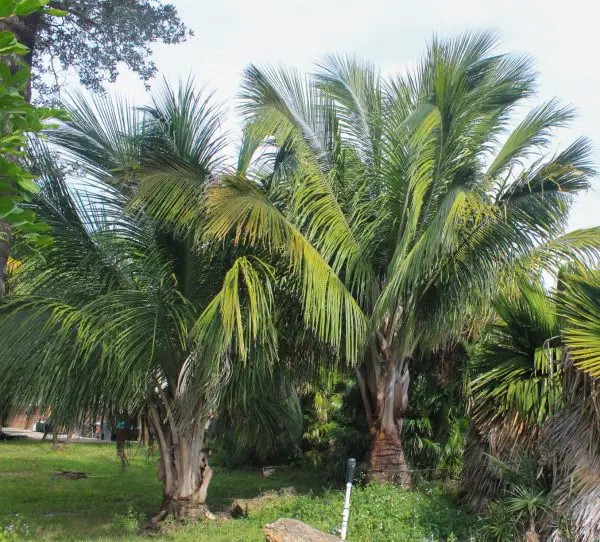
The Beccariophoenix Palm is a rare and impressive palm tree that resembles the Coconut Palm in appearance but is far more cold-hardy. It features a single, thick trunk and long, arching pinnate fronds that can grow up to 12 feet long, creating a full, tropical canopy. Mature specimens are majestic and dramatic in the landscape.
Native to the highlands of Madagascar, this palm is gaining popularity in Florida among collectors and landscapers seeking a cold-tolerant alternative to coconut palms. It can be found in specialized nurseries and botanical gardens throughout central and southern parts of the state. Though relatively rare, it is increasingly planted in upscale tropical landscapes.
Beccariophoenix Palm grows best in USDA zones 9B to 11 and can withstand temperatures down to the mid-20s Fahrenheit once established. It prefers full sun and moist, well-drained soil. Regular watering and a balanced fertilizer promote healthy growth, though it is tolerant of occasional drought. This palm grows moderately fast compared to other tropical palms.
Radicalis Palm (Chamaedorea radicalis)

The Radicalis Palm is a compact, shade-loving palm that is highly valued for its hardiness and slender, graceful appearance. It typically forms a single trunk or clumps of thin, bamboo-like stems with feather-shaped, deep green leaves. Its subtle and elegant form makes it an excellent choice for understory planting or indoor settings.
Native to the mountainous rainforests of northeastern Mexico, this palm is increasingly used in Florida landscapes, particularly in shaded areas of Central and North Florida where other tropical palms might struggle. It’s also well-suited for protected courtyards or container culture on shaded patios.
Radicalis Palm grows best in USDA zones 8B to 11, making it one of the most cold-tolerant Chamaedorea species. It thrives in partial to full shade and requires moist, well-drained soil. Water regularly, especially during dry periods, and provide organic mulch to help retain soil moisture. It grows slowly but is low-maintenance and highly adaptable.
Ernesti-Augusti Palm (Chamaedorea ernesti-augusti)
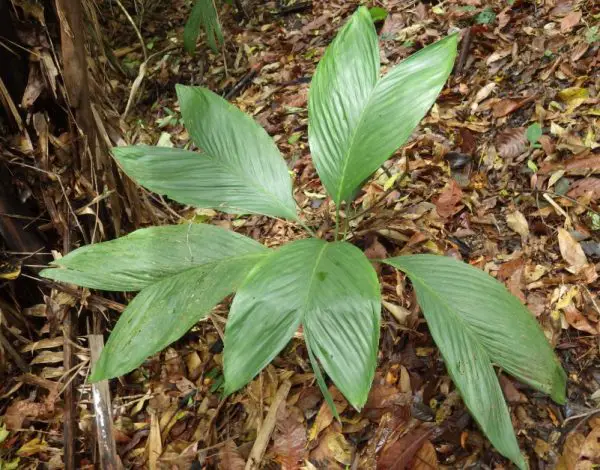
The Ernesti-Augusti Palm stands out for its unique broad, undivided leaves, which resemble paddle or fishtail shapes rather than the typical feathered fronds of most palms. This gives the plant a tropical, ornamental flair that is perfect for accent planting in shaded garden areas or as a striking houseplant.
Native to Central America, this palm is less common in Florida landscapes but prized by collectors and shade garden enthusiasts. Its distinctive leaves make it a focal point in tropical-themed settings, and it’s especially effective in pots or protected garden beds beneath taller trees.
Best suited for USDA zones 10 to 11, the Ernesti-Augusti Palm prefers full to partial shade and consistently moist, well-drained soil. It benefits from regular watering and high humidity but is sensitive to direct sunlight, which can burn its leaves. Fertilize lightly during the growing season, and protect from cold snaps if grown outdoors in borderline zones.
Plumosa Palm (Chamaedorea plumosa)
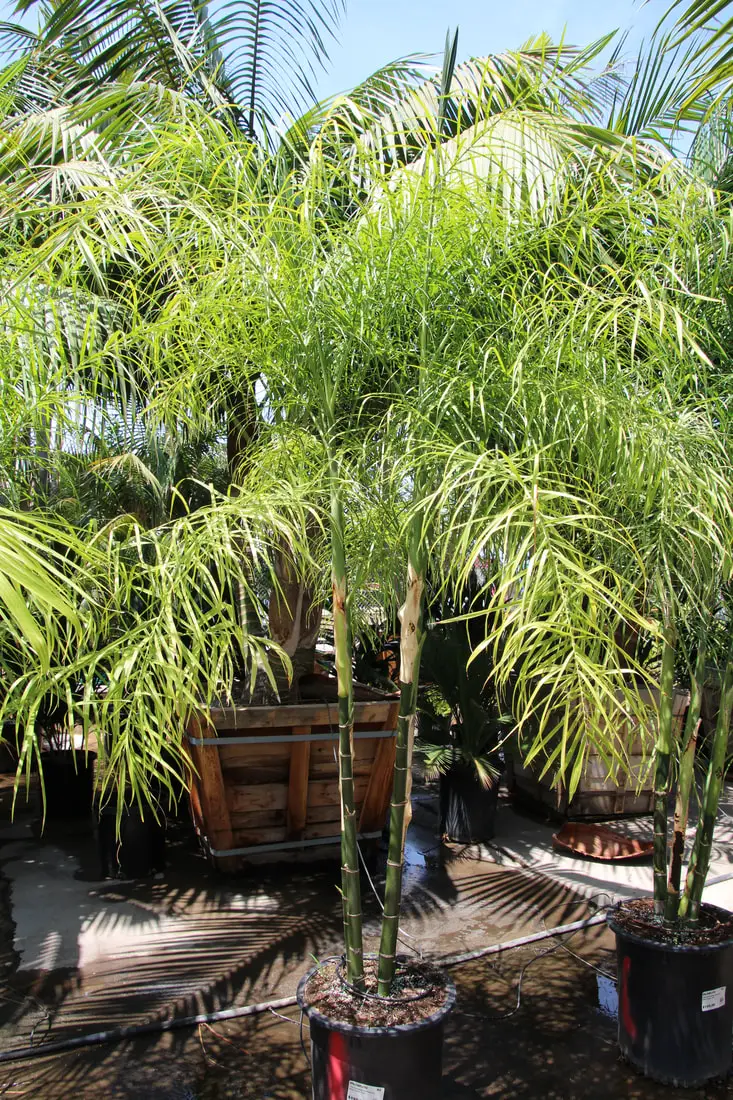
The Plumosa Palm is known for its fine, plumelike fronds that give it a soft, feathery appearance. It is a fast-growing, slender palm that can reach up to 10 feet tall and produces a single, upright trunk, making it ideal for narrow spaces or as an elegant focal point in tropical gardens.
Originally native to Guatemala, the Plumosa Palm has gained popularity in Florida for both landscape and indoor use. Its graceful silhouette and light foliage create a relaxed, tropical vibe in shaded borders, patios, or as part of a layered planting scheme in protected garden zones.
It grows best in USDA zones 10 to 11 and prefers part shade to full shade. It thrives in moist, well-draining soil and benefits from regular watering and monthly feeding with a balanced palm fertilizer. Its rapid growth and aesthetic beauty make it an excellent choice for adding vertical interest to small gardens or containers.
Tepejilote Palm (Chamaedorea tepejilote)
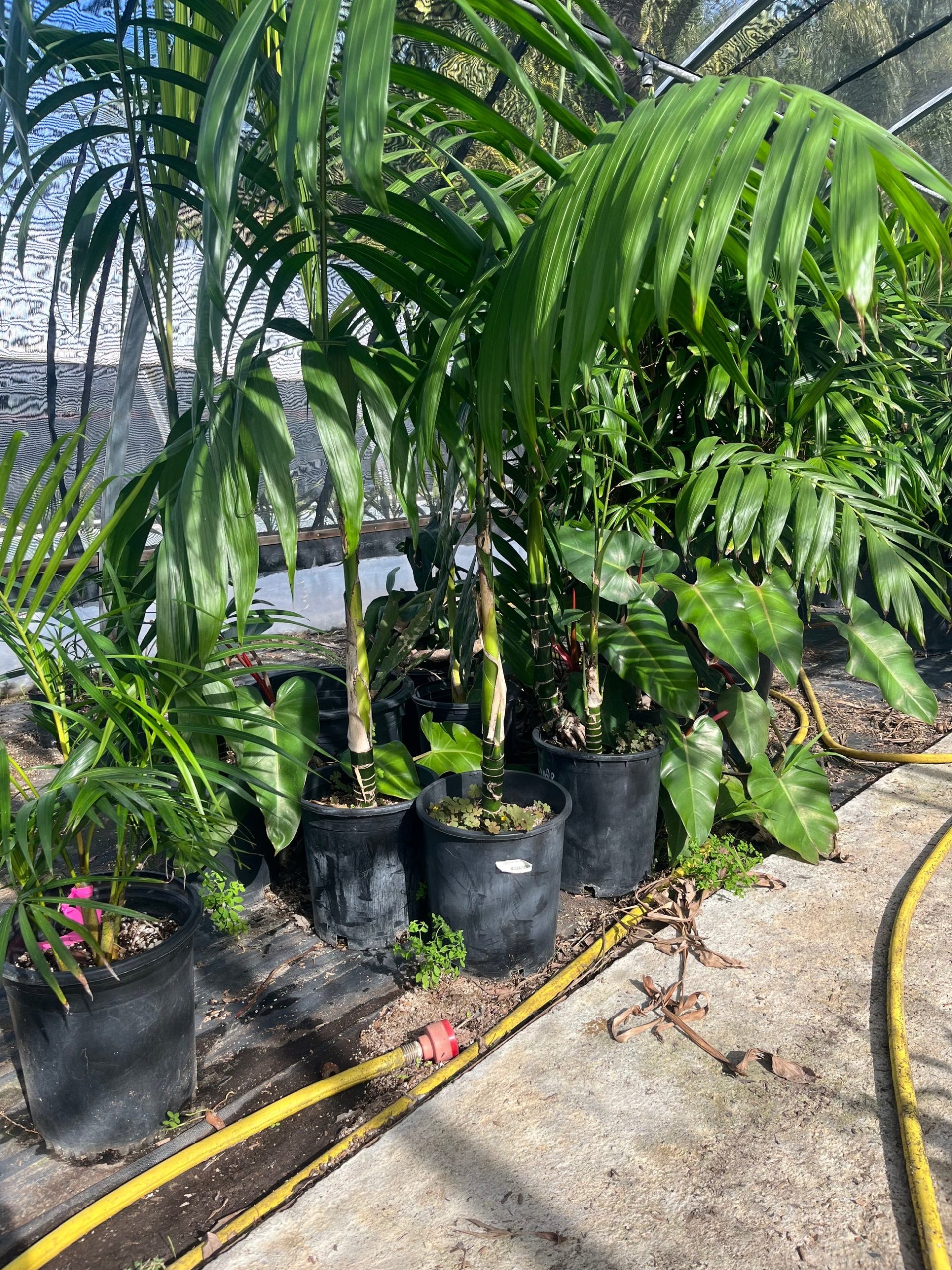
The Tepejilote Palm is a slender, slow-growing palm that is unique among its genus for producing edible flower buds, commonly consumed in Central America. It features a thin, upright trunk and dark green, feather-like fronds, making it both ornamental and functional in tropical gardens.
Native to Mexico and Central America, this palm is cultivated primarily for specialty gardens and botanical collections in Florida, especially in the southern part of the state. It does best in humid, shaded environments and contributes a lush, vertical element to understory plantings.
It thrives in USDA zones 10 to 11 and requires well-drained, rich soil with regular watering. High humidity and partial to full shade are ideal for its healthy growth. While it’s not widely grown outside of specialty collections, its unique characteristics make it a rare and interesting addition to Florida gardens with tropical or edible landscaping themes.
Woodsoniana Palm (Chamaedorea woodsoniana)

The Woodsoniana Palm is a large, elegant species of Chamaedorea that can reach heights of up to 20 feet, making it one of the tallest in its genus. It features a single, smooth trunk and large, arching fronds with broad leaflets, giving it a stately appearance perfect for shaded tropical landscapes.
This palm is native to Central American rainforests and is rarely seen outside of specialized collections or large shade gardens in Florida. However, its imposing size and lush foliage make it highly desirable for creating vertical structure and tropical atmosphere in protected outdoor spaces.
Suited for USDA zones 10 to 11, the Woodsoniana Palm thrives in rich, moist soil with consistent watering and partial to full shade. It appreciates high humidity and benefits from regular mulching and fertilizing. Though it’s less common in retail nurseries, it is highly valued by collectors and experienced gardeners seeking a tall, dramatic palm for shaded areas.
Zamora Palm (Chamaedorea zamorae)
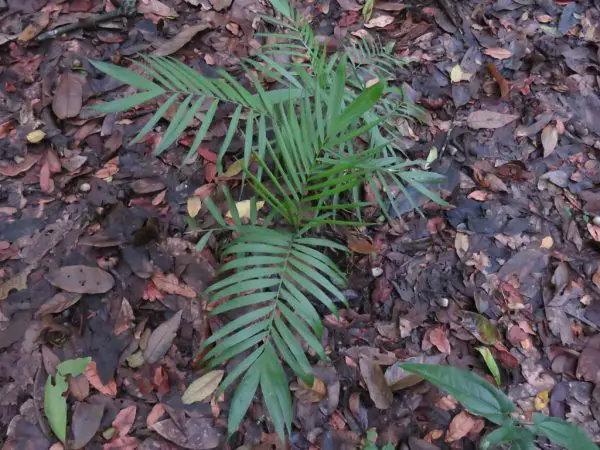
The Zamora Palm is a rare and elegant palm with dark green, finely pinnate fronds and a slender stem that gives it a refined appearance. This species remains relatively compact, making it ideal for smaller gardens or indoor containers. Its fronds are soft and arch gracefully, creating a lush, tropical look even in tight spaces.
Native to the shaded forests of southern Mexico and Central America, the Zamora Palm is not commonly seen in Florida landscapes but can thrive in suitable microclimates, especially in South Florida. Its adaptability to low light makes it a desirable indoor palm for tropical plant collectors.
The palm grows slowly and prefers USDA zones 10 to 11. It thrives in partial to full shade and requires moist, well-drained soil with consistent humidity. Regular watering and protection from cold temperatures are essential. Though uncommon, it rewards gardeners with its graceful structure and low-maintenance nature when grown under the right conditions.
Tenella Palm (Chamaedorea tenella)
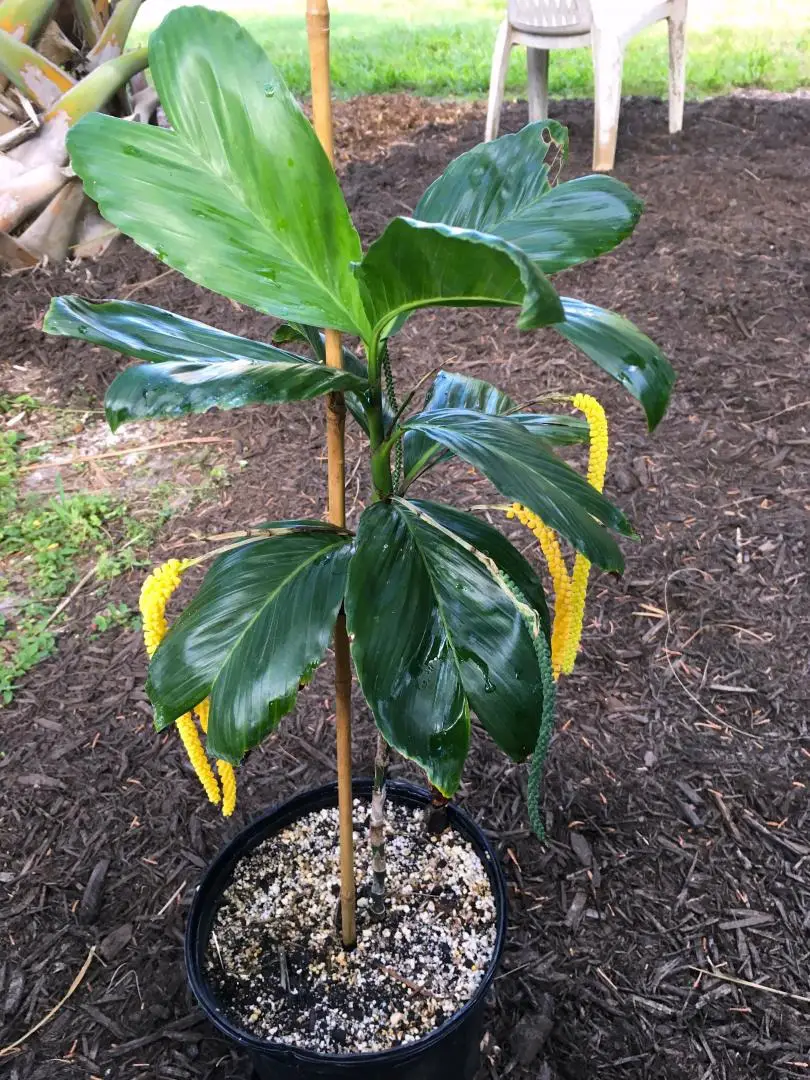
The Tenella Palm is one of the smallest and most delicate members of the Chamaedorea genus. It typically remains under 3 feet tall, with narrow leaflets and a clumping growth habit, making it perfect for terrariums, pots, or the understory of densely planted tropical gardens. Its fine texture lends a soft, graceful quality to any planting arrangement.
Native to the cloud forests of Central America, it is extremely rare in cultivation, including in Florida. However, it can be grown successfully in humid, protected environments such as shade houses, greenhouses, or covered patios in South Florida.
Best suited for USDA zones 10B to 11, the Tenella Palm needs high humidity, shade, and consistent moisture. It is sensitive to cold and drought and benefits from a rich, well-drained soil mix. Regular misting and avoiding direct sun exposure will help this fragile species thrive indoors or in controlled outdoor conditions.
Glaucifolia Palm (Chamaedorea glaucifolia)
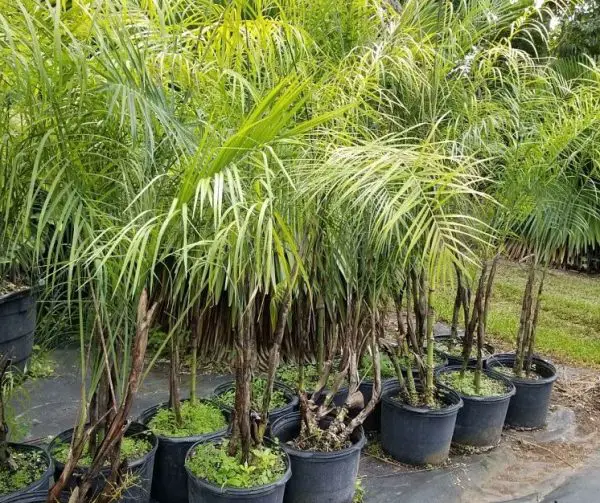
The Glaucifolia Palm is named for its striking blue-green (glaucous) foliage, which sets it apart from many other palms in the Chamaedorea genus. Its elegant, arching fronds and slender stem make it a visually attractive choice for shady, decorative plantings or container displays.
Native to Honduras and neighboring regions, this palm is relatively unknown in Florida but has potential as a landscape or indoor plant in southern parts of the state. Its unique foliage color makes it especially appealing in tropical-themed or foliage-focused gardens.
It grows best in USDA zones 10 to 11 and requires high humidity, regular watering, and protection from intense sunlight. It does well in filtered light or deep shade and should be planted in rich, well-draining soil. While rare, it is valued by enthusiasts for its distinctive look and soft, tropical elegance.
Obscura Palm (Chamaedorea obscura)
The Obscura Palm is a rare and lesser-known species that features slender, upright growth and soft, divided fronds. Its subtle and understated appearance makes it an ideal background or filler palm in shady, humid garden spaces. Its name “obscura” reflects its relatively hidden status among palm collectors.
Originating from tropical Central American forests, this palm is very rarely cultivated in Florida, mostly found in private collections or botanical gardens. However, it can adapt well to Florida’s southernmost climates when given sufficient humidity and shade.
Suited for USDA zones 10B to 11, the Obscura Palm grows slowly and benefits from filtered light, moist soil, and shelter from wind and cold. It prefers a protected, humid environment with regular misting and mulching to retain moisture. Due to its rarity, it is typically grown by enthusiasts with experience in tropical plant care.
Quezalteca Palm (Chamaedorea quezalteca)
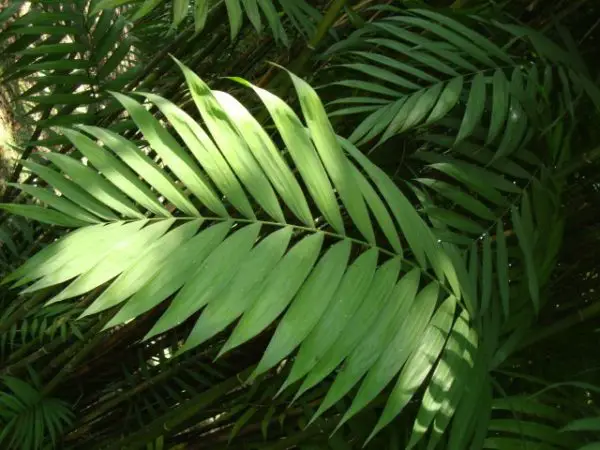
The Quezalteca Palm is a small, elegant palm named after the region of Quezaltenango in Guatemala. It grows as a solitary or slightly clustering plant with graceful, feather-like fronds that give it a refined, arching form. It is prized for its ornamental value and compact habit.
Native to the shaded rainforests of Central America, the Quezalteca Palm is uncommon in Florida but can be cultivated in the warm, humid regions of the southern part of the state. It is particularly suited to shaded gardens or interior plant collections, thanks to its tolerance for low light.
This palm prefers USDA zones 10B to 11 and grows slowly in consistently moist, well-drained soil. It thrives in high humidity and shade, making it ideal for protected courtyards or indoor green spaces. Regular watering and a sheltered location away from direct sunlight are key to its successful growth.
Sartorii Palm (Chamaedorea sartorii)
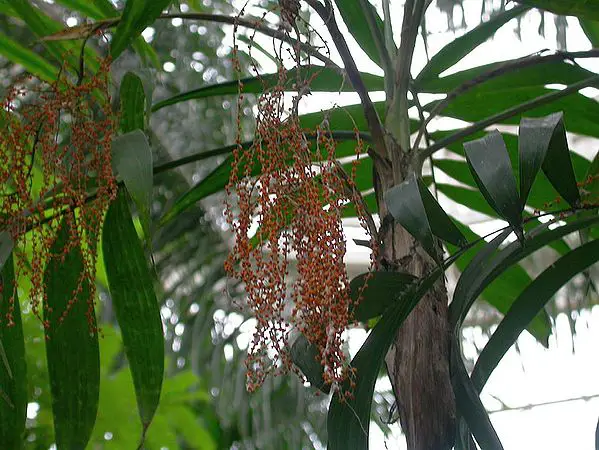
The Sartorii Palm is a rare and graceful palm known for its fine-textured fronds and upright growth habit. Its foliage consists of narrow, arching leaflets arranged on slender stems, giving it a soft and elegant appearance. This palm remains small and compact, making it suitable for indoor containers or shady garden corners.
Native to the humid forests of southern Mexico and Central America, it is rarely seen in Florida landscapes but can thrive in specialized collections and tropical garden setups in South Florida. Its delicate foliage makes it a favorite among collectors who seek rare and visually appealing species.
It performs best in USDA zones 10B to 11 and prefers shaded or filtered light conditions. The Sartorii Palm needs consistent moisture, high humidity, and well-drained, fertile soil. Regular misting, mulching, and protection from cold and direct sun are essential to maintain its health and vibrant foliage.
Schiedeana Palm (Chamaedorea schiedeana)
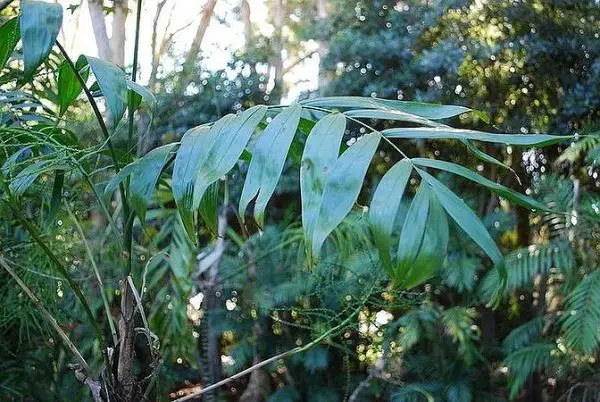
The Schiedeana Palm is a slender, solitary palm with glossy green, pinnate fronds that lend a neat and vertical silhouette. It produces small yellow flowers followed by black fruit and often has a bamboo-like appearance due to its green ringed trunk.
Native to Mexico and Central America, this species is known for its adaptability and is more common in cultivation than many of its relatives. It has potential in Florida, especially in South Florida gardens or shaded urban landscapes where space is limited.
It grows in USDA zones 10 to 11 and prefers moist, well-drained soil in partial to full shade. This palm is moderately fast-growing under ideal conditions and requires consistent watering and humidity. With proper care, the Schiedeana Palm makes an elegant addition to both indoor and outdoor tropical plantings.
Torreyana Palm (Chamaedorea torreyana)
The Torreyana Palm is a clustering species that forms dense groups of slender stems with dark green, arching fronds. Its graceful, bamboo-like structure and lush foliage make it particularly appealing for screening or ornamental use in shaded landscapes.
It is native to the cloud forests of Central America and remains rare in cultivation. However, it can be grown in Florida’s southern regions where the climate is warm and moist year-round. This palm adds a lush, jungle-like effect to shaded gardens and is also suitable for greenhouse collections.
Well-suited for USDA zones 10B to 11, the Torreyana Palm thrives in consistently moist, humus-rich soil with good drainage. It prefers high humidity, filtered light, and protection from cold winds. Occasional pruning of older stems helps keep the clump tidy and encourages new growth.
Warscewiczii Palm (Chamaedorea warscewiczii)

The Warscewiczii Palm is highly prized for its attractive foliage and tropical elegance. It is a clustering palm with upright stems and broad, bipinnate fronds that resemble fern leaves. This unique leaf structure makes it stand out among other Chamaedorea species and adds a striking visual element to shaded spaces.
Native to Central America, including Honduras and Costa Rica, this palm is occasionally seen in botanical gardens and specialty nurseries in Florida. It prefers cool, moist, forest-like conditions and is best grown in South Florida or controlled indoor environments.
The Warscewiczii Palm does well in USDA zones 10B to 11. It thrives in high humidity, rich organic soil, and filtered light or deep shade. Regular watering, mulching, and misting are recommended to keep its delicate foliage looking its best. Avoid exposing it to direct sun or dry air to prevent leaf burn.
Zongolicana Palm (Chamaedorea zongolicana)
The Zongolicana Palm is a lesser-known species with fine, arching fronds and a compact growth form that makes it ideal for indoor cultivation or small tropical gardens. It features a slender trunk and a soft crown of feather-like leaves that gently sway in the breeze.
It originates from the cloud forests of Veracruz, Mexico, where it grows in humid, shaded environments. In Florida, it is quite rare but can be grown successfully in South Florida under similar conditions, especially in shaded garden beds or protected patios.
Thriving in USDA zones 10B to 11, the Zongolicana Palm prefers moist, well-draining soil, high humidity, and partial to full shade. It requires consistent care, including regular watering and humidity maintenance. Its adaptability to indoor environments also makes it a good choice for collectors or low-light spaces.
Adscendens Palm (Chamaedorea adscendens)
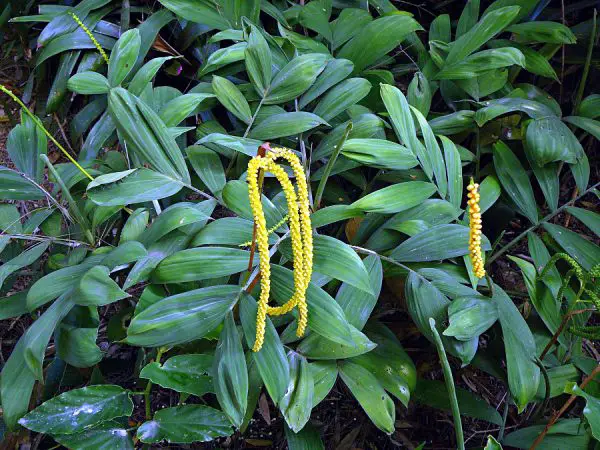
The Adscendens Palm is a rare, slender-stemmed palm known for its climbing or ascending growth habit. It typically grows as a small, multi-stemmed plant with long, narrow leaflets that give it a fine-textured, airy appearance. This unique palm often scrambles over rocks or other vegetation in its natural environment.
Native to the moist forests of Central America, the Adscendens Palm is not widely cultivated but may appear in botanical collections or specialty tropical gardens. In Florida, it is best suited to protected areas in South Florida, especially in shaded courtyards or covered patios where humidity is high.
Best grown in USDA zones 10B to 11, this palm prefers consistently moist, well-draining soil and thrives in low to medium light conditions. Regular watering, high humidity, and some structural support (such as a moss pole or trellis) will help it grow well. Its unusual climbing habit makes it a standout in indoor tropical plant displays.
Anemophila Palm (Chamaedorea anemophila)
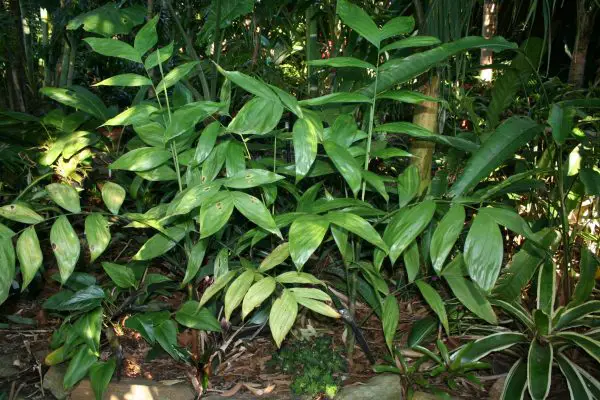
The Anemophila Palm is named for its light, wind-tossed appearance, characterized by delicate, fine-textured fronds that gently sway. This palm features gracefully arching leaves on slender green stems and remains compact, making it ideal for indoor settings or small garden spaces.
Found in the humid mountain forests of Central America, this species is uncommon in Florida but may be appreciated by palm enthusiasts for its elegance and rarity. It performs best in locations with stable humidity and protection from harsh sunlight.
Thriving in USDA zones 10B to 11, the Anemophila Palm needs partial shade, organically rich soil, and moderate, even moisture. It’s relatively slow-growing but rewards careful attention with lush, graceful foliage. Occasional misting and avoiding dry conditions will ensure its continued health and beauty.
Arenbergiana Palm (Chamaedorea arenbergiana)
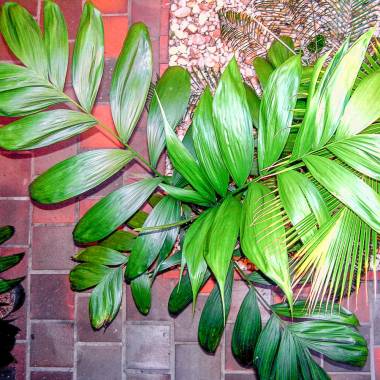
The Arenbergiana Palm is a compact, clumping palm known for its upright growth and broad, deep green fronds. It has a neat, bushy appearance with multiple stems emerging from the base, and its lush foliage creates a dense screen when planted in groups.
Native to Central American rainforests, it adapts well to humid, shaded environments and is suitable for Florida’s southern climate, especially in protected gardens, shaded patios, or indoor containers. Its bold texture makes it attractive for creating privacy or tropical ambiance.
Well-suited for USDA zones 10 to 11, this palm needs rich, well-drained soil and consistent moisture. Partial to full shade and high humidity are ideal. Regular feeding with a balanced palm fertilizer and pruning of spent fronds will help maintain its compact, healthy form.
Atrovirens Palm (Chamaedorea atrovirens)
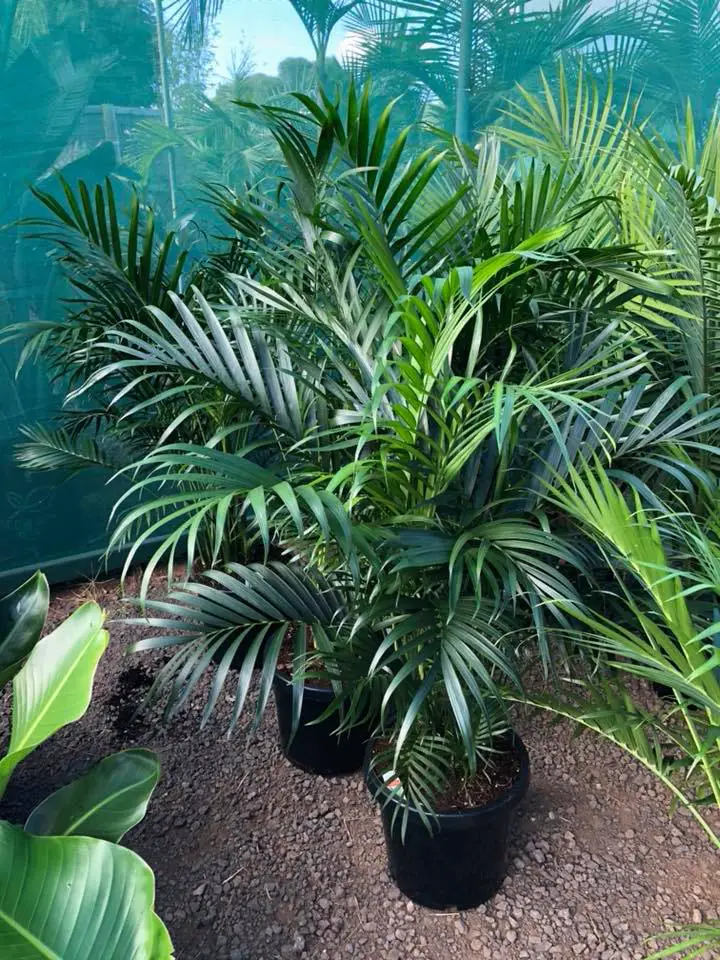
The Atrovirens Palm is a stately, solitary palm with glossy, dark green fronds and a tall, upright habit. The name “atrovirens” refers to its deeply colored leaves, which offer striking contrast in shaded tropical gardens. Its leaflets are long and evenly spaced, creating a uniform, elegant canopy.
It is native to the highland forests of Central America and remains rare in cultivation. In Florida, it may be seen in specialized collections or botanical gardens, particularly in the warm, humid climate of the southern part of the state.
The Atrovirens Palm thrives in USDA zones 10B to 11. It grows best in filtered light or partial shade, preferring moist, fertile soil and sheltered locations. This palm benefits from regular irrigation and misting. Protection from strong winds and cold temperatures is essential due to its delicate fronds and tropical origins.
Benzei Palm (Chamaedorea benzei)
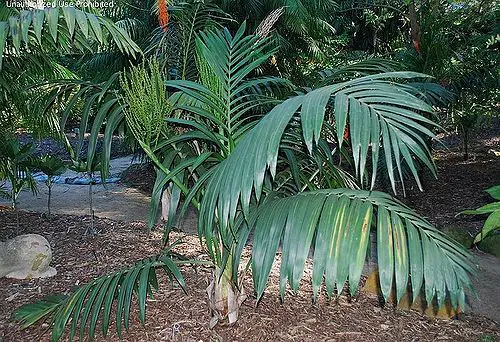
The Benzei Palm is a small, clustering palm known for its slender canes and feather-like fronds. Its foliage is soft and arching, with a graceful shape that fits well in shaded landscapes or indoor plant collections. It maintains a tidy, upright growth pattern, perfect for small spaces.
This species originates from tropical rainforests in Central America and is seldom seen in commercial cultivation. In Florida, it can be grown in protected gardens or greenhouses, particularly in South Florida’s subtropical climate.
Best suited to USDA zones 10B to 11, the Benzei Palm thrives in high humidity and filtered light. It prefers well-draining soil kept consistently moist and responds well to regular misting. Grouping multiple specimens can enhance humidity and encourage fuller growth, making it ideal for lush, tropical plantings.
Brevispatha Palm (Chamaedorea brevispatha)
The Brevispatha Palm is a delicate, small palm species recognized for its slender stems and finely divided, pinnate fronds. It grows in tight clusters, giving it a dense yet airy appearance that fits well in shaded garden corners or indoor settings. Its compact size makes it ideal for spaces where a subtropical touch is desired without overwhelming the area.
Native to tropical forests in Central America, the Brevispatha Palm thrives in humid, shaded environments. It is uncommon in Florida landscapes but can be cultivated in South Florida gardens or greenhouses where conditions mimic its natural habitat. Its preference for low light and consistent moisture makes it a good candidate for indoor growing.
This palm grows best in USDA zones 10B to 11, preferring rich, well-draining soil with high organic content. It requires partial to full shade and benefits from regular watering and misting to maintain humidity. Protecting it from cold snaps and direct sun is important to avoid leaf damage and ensure healthy growth.
Carchensis Palm (Chamaedorea carchensis)

The Carchensis Palm is a relatively rare palm characterized by its slender, upright stems and delicate, feathery fronds. It forms small clumps and features dark green foliage that adds a graceful tropical look to shaded areas. Its compact form makes it suitable for both indoor cultivation and garden use.
Originating from the moist forests of Ecuador and Colombia, the Carchensis Palm is less common in Florida but can adapt well to similar humid, warm conditions found in South Florida. It thrives in environments that replicate its native understory habitat, with filtered light and good air circulation.
Growing in USDA zones 10 to 11, this palm prefers consistently moist, fertile soil with excellent drainage. Partial shade to full shade conditions are ideal, as direct sunlight can scorch its delicate leaves. Regular watering, high humidity, and occasional fertilization will promote its lush growth.
Chontalensis Palm (Chamaedorea chontalensis)
The Chontalensis Palm is a slender, clumping palm that features narrow, arching leaflets and a neat, elegant appearance. Its stems grow in tight clusters, creating a bushy effect perfect for tropical landscaping or as an indoor ornamental plant. Its light green foliage provides a soft, feathery texture that enhances shaded garden spaces.
Native to southern Mexico and Central America, this palm is occasionally used in Florida’s tropical garden designs, particularly in the southern parts of the state. It prefers shaded, humid environments similar to its natural habitat in lowland rainforests.
The Chontalensis Palm grows well in USDA zones 10B to 11 and requires rich, moist soil with good drainage. It thrives in filtered light or partial shade and benefits from high humidity and regular watering. Protection from cold temperatures and harsh sun exposure is essential to maintain its delicate foliage and healthy growth.
Metallic Palm (Chamaedorea metallica)
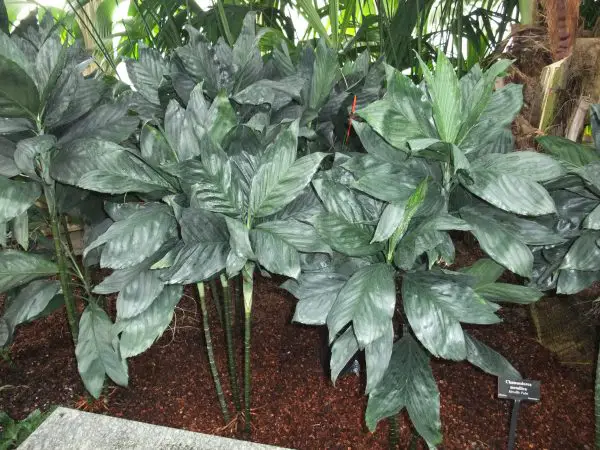
The Metallic Palm is admired for its distinctive shiny, metallic-looking leaves, which give it a striking and unusual appearance among palms. Its dark, glossy fronds have a silvery sheen that catches light beautifully, making it a popular choice for collectors and tropical garden enthusiasts looking for a unique specimen.
This species is native to the tropical forests of Central America and is less commonly cultivated than other Chamaedorea palms. In Florida, it can be grown in specialized collections and tropical gardens, especially in South Florida where the climate is warm and humid enough to support its needs.
It thrives in USDA zones 10B to 11, preferring moist, well-drained soil rich in organic matter. The Metallic Palm does best in partial shade or filtered light and requires consistent watering and humidity. Avoiding direct sunlight and cold drafts will help preserve the leaf coloration and overall health of this visually striking palm.

